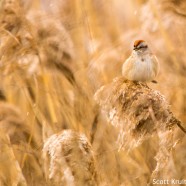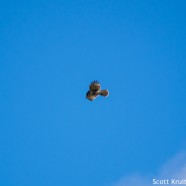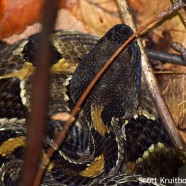American Tree Sparrow (Spizella arborea)
Here is an American Tree Sparrow (Spizella arborea) that I photographed during my hometown Christmas Bird Count in Stratford, Connecticut yesterday, part of a flock of perhaps 15 individuals that were staying mostly out of sight. I made sure to take the photo because it was feeding on Common Reed (Phragmites australis), one of the most notorious non-native invasive plants in North America. American Tree Sparrows are well-known as seed eaters and can often be found at the top of weeds and grasses, but I do not personally remember seeing them feeding on the “phrag” before. I wonder...
Read MoreHunting Red-tailed Hawk (Buteo jamaicensis)
This Red-tailed Hawk (Buteo jamaicensis) is on the hunt and you can tell this is the case by seeing where its head and eyes are pointed – straight down. It is also holding its wings and tail in positions for a lazy, floating flight. While it is not hovering it is using the wind to slowly comb over the landscape in search of small mammals. Even if you are far from the bird, like I was in this photo, you can often still see the distinctive “belly band” of dark splotches across the white undersides. We are about to hit the peak of their migration in the Northeast so be on the...
Read MoreMelanin deposit – Timber Rattlesnake
Do you see the perceptible streak of blue along the right side of the head of this Timber Rattlesnake? That is a special shield for its venom and venom glands that can be found in both pit vipers like Crotalus horridus as well as true vipers. This melanin deposit helps to block visible and ultraviolet light from harming the internal systems and prevents detoxification of the venom itself. That is some advanced evolution!
Read More






